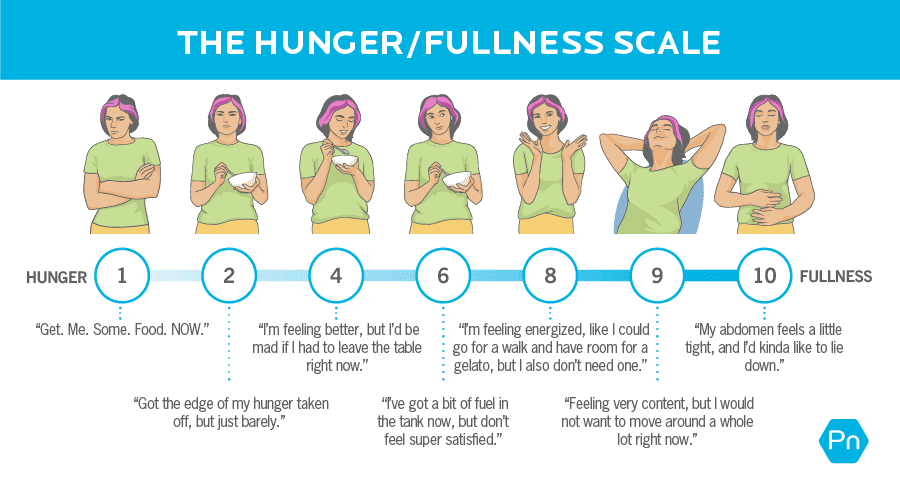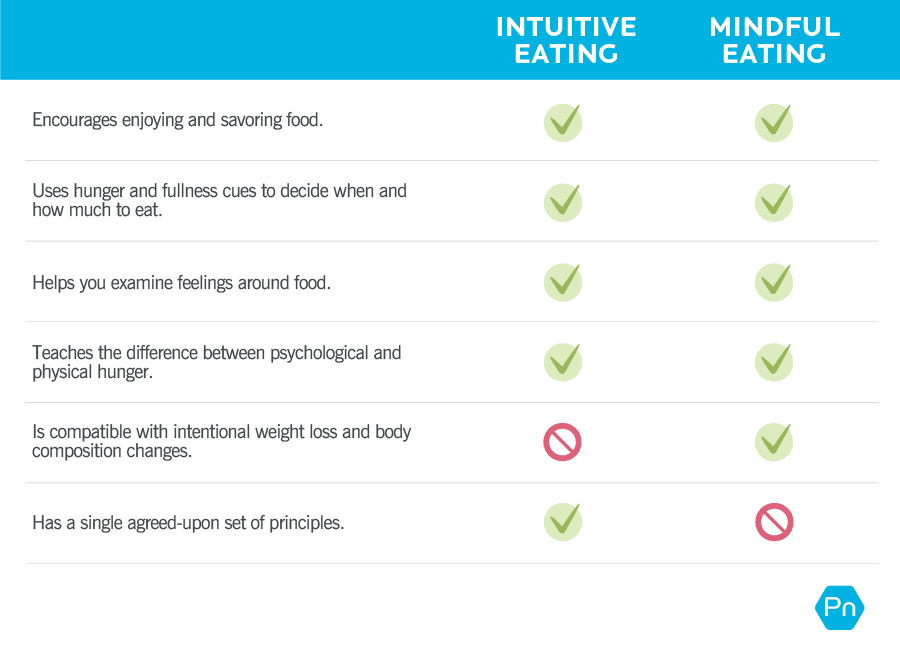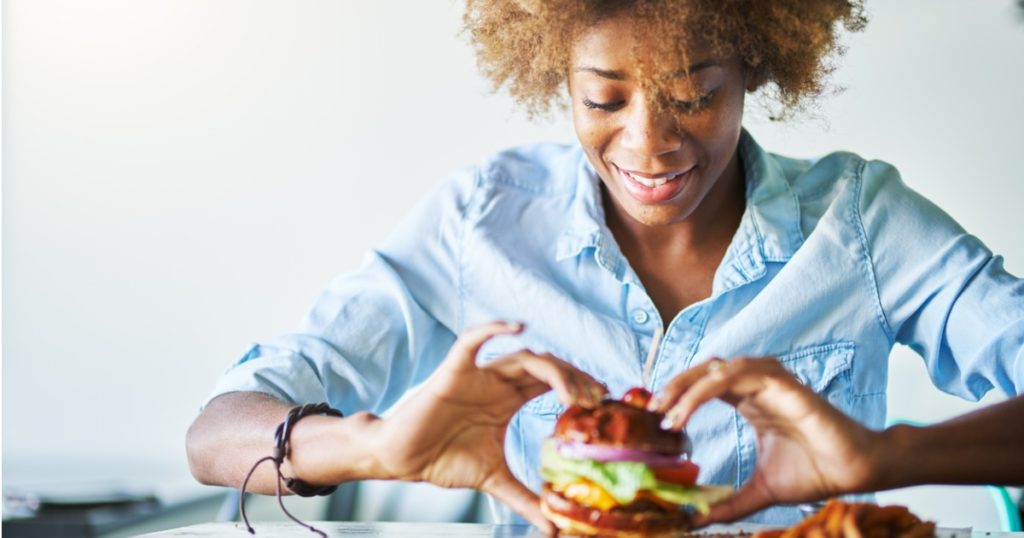Reviewed by: Pam Ruhland, PN2, Certified Intuitive Eating Lay Facilitator
What is it? | Principles | Weight loss | Mindful eating | Advice for coaches
Many people think they know what “intuitive eating” means.
And a lot of them are wrong.
They’ll say things like:
“Intuitive eating is eating whatever you want, whenever you want.”
“If you’re not on a diet, you’re already eating intuitively.”
Or everyone’s personal favorite: “It just means ‘listen to your body.’”
But none of those are accurate, at least not according to the people who coined the term.
And that matters.
Whether you’re interested in practicing intuitive eating yourself, or you’re a coach considering using it with your clients, you’ll want to know what intuitive eating is and isn’t—so you can decide whether it’s the right tool for the job.
In this article, you’ll discover:
- The 10 principles of intuitive eating.
- Why intuitive eating might be right—or wrong—for you (or your clients).
- A number of handy ways to try intuitive eating—starting today.
Ready? Let’s dig in.
++++
What is intuitive eating?
First popularized by Evelyn Tribole and Elyse Resch in their 1995 book Intuitive Eating: A Revolutionary Anti-Diet Approach, intuitive eating rejects diet culture, a set of beliefs that values thinness, appearance, and shape above health and well-being.
This framework enthusiastically welcomes people of all sizes, helping them to improve their relationships with food, mind, and body without encouraging them to lose an ounce.
Intuitive eating also forgoes typical eating rules (think weighing, measuring) and instead helps people rediscover body cues like hunger and fullness.
That sounds great, of course. But can it really work?
For many people, intuitive eating can be powerfully transformative.
By the time we hit our 20s, most of us are eating for lots of reasons besides actual hunger.
6 pm? Time for dinner.
Bored? Let’s see what’s in the fridge.
Rough day? Give me a spoon and some cookies n’ cream.
But imagine how life might work out if we ate like babies.
Babies naturally eat intuitively, stopping when they’re full, no matter how much milk or formula is left.
They don’t go to battle with themselves thinking, “I want more. But, no, I shouldn’t. But, my gosh, it tastes so good. A little more won’t be so bad, right? What is wrong with me? Why can’t I stop?! Okay, I know. I’ll do 250 crawling laps around the room to burn off the extra milk…”
Intuitive eating helps people get closer to this natural instinct again.
The 10 intuitive eating principles
If you want to understand what intuitive eating has to offer, the 10 principles are a great place to start. One way to use these principles: Work through them in order. Master one, and then move on to the next, which is what the creators originally intended.
Principle #1: Reject the diet mentality.
Intuitive eating isn’t about weight loss, and that’s precisely what attracted Lisa Dahl, PN2, a Certified Intuitive Eating Lay Facilitator and body image coach.
She’d noticed that many of her clients felt stressed and upset when they stepped on the scale or tracked their measurements. So when she discovered intuitive eating, she shifted her entire coaching practice away from weight loss.
That shift had a major impact on Dahl’s clients and her coaching: “When we removed the diet mentality, we shifted our focus to behaviors and actions that were making them feel better—regardless of the number on the scale. It became a much more positive experience for both of us.”
If you’re interested in trying this approach, think about your goals outside of weight loss by using a thought experiment called The 5 Whys.
You start with the question: What do you want to accomplish? And then ask yourself why five times to get to the root of what you really want.
Often, people start by saying they want to lose weight. By the end, they end up with goals about confidence, happiness, and having a good life—all of which can be achieved without weight loss.
To learn more about how to use The 5 Whys to reject the diet mentality, see: Are you body-shaming clients? How well-meaning coaches can be guilty of “size-bias.”
But what about people who “need” to lose weight?
This is a loaded question. But there are a few important points to consider.
➤ #1: Not everyone who’s “overweight” or “obese” is unhealthy. Just as not everyone who’s at a “normal” body weight is healthy.
➤ #2: Focusing on weight loss simply doesn’t work for everyone. If it did, people would go on one diet, get the results they want, and never diet again. It’s safe to say that’s a pretty rare occurrence.
“We have to get rid of this idea that weight loss is always a good choice. It’s just not,” says Precision Nutrition Coach Jon Mills, PN2. “We tend to think that if you lose weight, you’ll get healthier. But if that comes with disordered eating, extra stress, and more body issues, weight loss isn’t the healthy choice.”
➤ #3: People who “need to lose weight” are constantly getting lectured about their bodies.
“I have so many clients who, every time they go to the doctor, no matter what the problem is, the doctor’s like, ‘You should lose weight,” says Mills. “We don’t need more people in the world being like, ‘Hey, have you considered losing weight?’ That messaging is saturated.”
If a person decides intuitive eating is right for them, regardless of their size, that’s their choice to make.
Principle #2: Honor your hunger.
The more we try to resist hunger, the more we want to eat. (Thank evolution for that one.)
And once we get extremely hungry? Our plan to eat a perfectly portioned chicken breast with a side of kale becomes a bucket of fried chicken with mashed potatoes and a side of cheesecake.
The solution? When you’re hungry—eat.
But that begs the question: How do you know when you’re truly hungry? Try ranking your hunger on a scale of 1-10. Usually, we think of 7 as “time to eat,” but what feels right for you might be different.
Letting your hunger guide you may mean eating at new and different times.
For instance, you may normally eat breakfast at 9 am out of habit. But maybe you’re super hungry right after you wake up at 7:30 am. Or you may find you’re not actually hungry until 10 am. Whatever your body tells you, go with it.
Principle #3: Make peace with food.
Give yourself unconditional permission to eat.
“When people are restricting really hard, that pushes them into binge eating and shame eating and emotional eating. You’ll never address a restriction problem with more restriction. It just doesn’t work,” says Mills.
If you’ve ever gone on a super restrictive diet and then crashed and burned face-first into a tub of caramel popcorn, you know what we’re talking about.
The goal of making peace with food is to avoid situations like that. But in order to get there, intuitive eating says you need to welcome yourself to eat that caramel popcorn whenever you want.
You’re probably wondering: Won’t unconditional permission lead to donuts the size of people’s heads coupled with a lifetime without vegetables?
Not usually.
Quite often, the opposite happens. Once people allow themselves to eat what they really want, their cravings suddenly don’t feel as urgent. That yearning for a whole box of cookies eventually turns into a more manageable desire for just one or two.
Fair warning, this principle can take a while to master.
One thing that might help: Self-compassion, which is an attitude of generosity, honesty, and kindness towards yourself. Try to notice what you say to yourself when you eat—especially if you are going for foods that you haven’t given yourself permission to eat in the past. If your internal chatter is negative, take a deep breath and consider: “Is this how I would talk to someone I love?” If not, think about what you might say to a friend who is trying to break free from a negative relationship with food. Then say those words—to yourself.
For a full rundown of how to give yourself permission to eat, along with several ways to use self compassion, see: Solutions for stress eating.
Principle #4: Challenge the food police.
The food police are those little people in your head telling you not to eat such a big portion, that this food is “good,” and that food is “bad.”
Of course, once those annoying head mates deem a food “bad,” that food becomes all the more attractive and irresistible.
So stop using phrases like “good foods” “bad foods” and “cheat meals,” recommends Denise Allen, a Precision Nutrition Women’s Coach.
If you’re planning a special meal that goes outside of what you’d normally eat, you could try calling it a “choice” meal instead of a cheat one, Allen says. Even better, don’t label it anything at all. It’s just a meal—there’s no need to assign morality to it.
“Language and words matter so much, and how you talk to yourself about this process makes a difference,” Allen adds.
To learn more about labeling foods, see: We’ve told 100,000 clients, “There are no bad foods.” And we’re not about to stop. Here’s why.
Principle #5: Discover the satisfaction factor.
Taking pleasure in what you eat—enjoying food that you truly like in a comfortable environment—helps you innately decide when you’ve had “enough” to eat, whatever that means to you.
To do it, consider transforming your meals into an event.
Rather than scarfing things down over the sink or in the car, sit down—at a table. Maybe put some mood music on. Then consciously think about:
- What does your meal taste like?
- What’s the texture like?
- What does the chair you’re sitting in feel like?
- Who are you eating with? Is that part of your meal enjoyable?
- What’s good about your experience of eating this meal?
Principle #6: Feel your fullness.
As you eat, look and listen for the signs you’re no longer hungry.
Imagine your fullness on a scale from 1 to 10. One is “I don’t feel like I’ve eaten at all” and 10 is “I’m completely full and can’t eat any more.” Five is something like “I’ve eaten some food, but I definitely have room for more.”

Ask yourself (or your client): What level of fullness feels right to you? Some people might want to be at a 7 or 8 when they’re done eating. Others might want to get closer to 9 or 10.
If you struggle to stay tuned in for an entire meal, try checking in just three times: during the first, middle, and last bites. (Of course, the middle bite will usually be approximate.)
Experiment until you figure out what’s right for you.
Principle #7: Cope with your emotions with kindness.
Intuitive eating nudges you to ask important questions, especially when you find yourself turning to food when you’re not physically hungry. Rather than berating yourself, you gently explore what’s really going on by asking yourself:
“What do I really need? Is it connection? Better relationships? Am I feeling tired, stressed, frustrated?”
Those questions might lead you to much more nourishing solutions that happen to be located far outside of the kitchen.
“Intuitive eating is about being willing to listen, trust, and respect your thoughts and body,” Dahl adds. “It’s not a free-for-all; it’s actually about digging deep. It takes time, patience, practice, and self-compassion.”
One great resource to get you (or a client) started: The Break The Chain Worksheet, which helps you examine what’s really behind experiences like stress eating, cravings, and feeling out of control around food.
Principle #8: Respect your body.
Stop measuring your body against outside standards of how it “should” look. Instead, try to accept your body as it is.
In a world where we’re bombarded with images of what our bodies are “supposed” to look like, this is often a challenge. But it’s crucial.
All bodies are different, and for many of us, it can be helpful to accept that our bodies may never look like the ones on the cover of fitness magazines. With intuitive eating, you’re encouraged to lean into that and practice not feeling bad about it.
Principle #9: Movement—feel the difference.
Choose movement that feels good to you, and that you genuinely enjoy.
Hate running? Don’t force it. Love Zumba? Stick with that.
Or maybe you don’t like purposeful workouts at all. In that case, you might just focus on moving your body as much as possible throughout the day.
Principle #10: Honor your health—with gentle nutrition.
Intuitive eating is basically the opposite of most other approaches when it comes to how they handle the nutrition piece. Generally, diets focus on the relative health of various foods and what to eat before anything else.
Intuitive eating, on the other hand, deliberately does the opposite. You focus first on tapping into hunger and fullness signals, emotional awareness around food, and body respect.
Then you start talking about practical points like how much protein you need or the idea that adding veggies to your meal is usually a good move. And even when you consider these nutritional fundamentals, you do so hand-in-hand with pleasure. This isn’t about forcing yourself to eat nutritious foods that you hate. As Precision Nutrition super coach Kate Solovieva says, “It does not matter how good kale is for you, if you hate kale.”
Who should try intuitive eating?
When it comes to choosing an eating strategy, it’s all about picking the right tool for the right job.
So consider your (or your client’s) goals before making a decision on whether to try intuitive eating.
Intuitive eating fits these goals:
✓ Improving your relationship with food
✓ Recovering from disordered eating
✓ Reducing guilt around food
✓ Letting go of diet culture
✓ Getting to know your hunger and fullness signals
✓ Living as well as you can for as long as you can
For these goals, intuitive eating isn’t the best choice:
✓ Purposeful weight loss or body composition changes
✓ Preparing for an athletic competition or performance that has specific nutrient needs
✓ Changing the way your body looks for a modeling or acting job
Caveat: Intuitive eating principles can benefit athletes and people who get paid for their appearance when combined with other nutritional strategies. But again, intuitive eating isn’t meant to be used for purposeful weight loss, and it alone probably won’t help them reach their goals.
An alternative: Mindful eating
Intuitive eating and mindful eating often get confused, probably because they’re similar in many ways.

Here’s yet another alternative: blending mindful eating and parts of intuitive eating with nutrition fundamentals.
That’s what we do at Precision Nutrition. We’re agnostic when it comes to the best way to eat, but we do incorporate some principles of both mindful and intuitive eating with our clients and in our certification.
We teach clients how to sense into their hunger and fullness, notice and name the thoughts and emotions that trigger cravings, and to eat slowly and deeply enjoy every bite.
In addition, we show clients how to include protein and veggies with meals. And for people interested in fat loss, we explain how to tap into hunger and fullness cues to eat to 80 percent full.
Where to go next: Intuitive eating advice for coaches
Whether or not you agree with the premise of intuitive eating, it’s worth exposing yourself to the methodology, Mills says.
Aside from the book by Tribole and Resch, you might also want to check out some of the following resources:
- Health at Every Size: The Surprising Truth About Your Weight by Lindo Bacon
- Body Kindness by Rebecca Scritchfield
- Anti-Diet by Christy Harrison
Some coaches reject intuitive eating without truly exploring it, Mills points out. “But it speaks to a really prevalent demographic, which is people who have been deeply hurt by diet culture. And when you understand that context, intuitive eating makes perfect sense.”
If you’re a coach, or you want to be…
You can help people build sustainable nutrition and lifestyle habits that will significantly improve their physical and mental health—while you make a great living doing what you love. We'll show you how.
If you’d like to learn more, consider the PN Level 1 Nutrition Coaching Certification. (You can enroll now at a big discount.)





Share